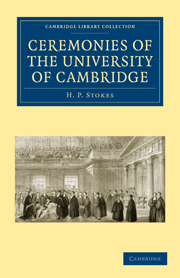Book contents
- Frontmatter
- Prefatory Note
- Contents
- ILLUSTRATIONS
- The Chancellor
- The Vice-Chancellor
- The Registrary
- The Proctors
- The Esquire Bedells
- Matriculation
- Congregations and Graces
- Degrees
- Commencement Day
- Insignia Doctoralia
- Honorary Degrees
- University Costume
- Processions
- The Presentation of an Address to H.M. The King
- The Bidding Prayer
- University Sermons
- The Orator
- The High Steward
- Representation in Parliament
- The Commissary
- University Discipline; the Sex Viri, etc.
- H.M. Judges and Trinity College
- The Admission of the newly elected Master of Trinity
- Commemoration of Benefactors
- The University and College Chests
- Obsolete Officers
- The University and Stourbridge Fair
- The University Arms
- The University Motto
- Index
- Plate section
Representation in Parliament
Published online by Cambridge University Press: 05 April 2012
- Frontmatter
- Prefatory Note
- Contents
- ILLUSTRATIONS
- The Chancellor
- The Vice-Chancellor
- The Registrary
- The Proctors
- The Esquire Bedells
- Matriculation
- Congregations and Graces
- Degrees
- Commencement Day
- Insignia Doctoralia
- Honorary Degrees
- University Costume
- Processions
- The Presentation of an Address to H.M. The King
- The Bidding Prayer
- University Sermons
- The Orator
- The High Steward
- Representation in Parliament
- The Commissary
- University Discipline; the Sex Viri, etc.
- H.M. Judges and Trinity College
- The Admission of the newly elected Master of Trinity
- Commemoration of Benefactors
- The University and College Chests
- Obsolete Officers
- The University and Stourbridge Fair
- The University Arms
- The University Motto
- Index
- Plate section
Summary
Since the beginning of the reign of James I, the University has been entitled to send two representatives to Parliament; and the honour has been keenly sought after. A long list of distinguished “burgesses” might be quoted. They are always conspicuous in University Processions.
The election of representatives of the University in Parliament now is governed by The Representation of the People Act, 1918 (8 Geo. V, chap. 64).
The University retains the right of sending two members to Parliament, which it has enjoyed since 1603, and this franchise may be exercised in addition to the ordinary franchise, but certain important changes have been made by the Act: (1) the right of voting is no longer restricted to Members of the Senate, but is extended to all graduates, and includes women who would have been graduates if the University had granted Degrees to women students; and (2) in order to promote the representation of minorities, each elector has only one transferable vote. The right of voting by proxy is still retained, in certain cases.
For the method of voting, see “The Proxy Paper (Universities) Order, 1918” (Statutory Rules and Orders, 1918, no. 1350), where the form of a proxy paper is set out and the regulations with regard to proxies are laid down.
- Type
- Chapter
- Information
- Ceremonies of the University of Cambridge , pp. 61 - 62Publisher: Cambridge University PressPrint publication year: 2009First published in: 1927



